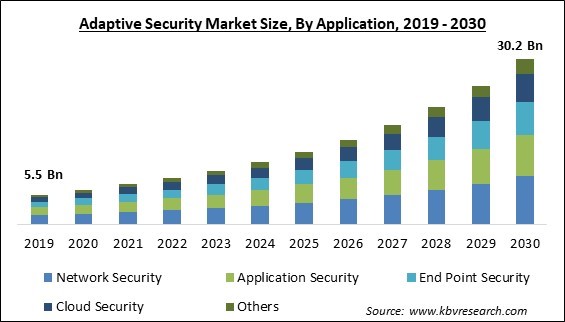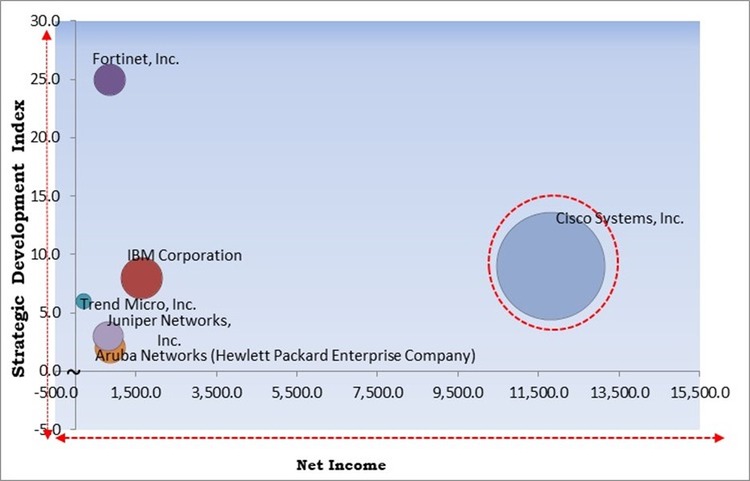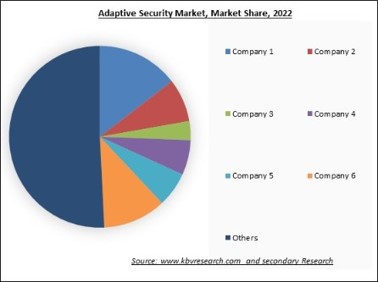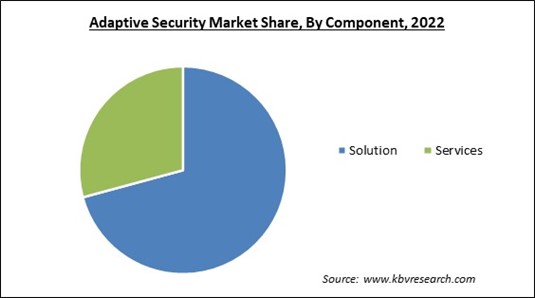The Global Adaptive Security Market size is expected to reach $30.2 billion by 2030, rising at a market growth of 17.4% CAGR during the forecast period.
Due to the fast growth in technological adoption throughout various industries, such as manufacturing, healthcare, logistics, smart cities, and agriculture, Asia-Pacific region will acquire approximately 1/4th share of the market by 2030. As the Indian government launched the Digital India initiative to transform India into a digitally empowered society and knowledge-based economy. The Korean government unveiled its "New Deal" initiative, which incorporates the Korean Digital New Deal, a strategy to achieve national digital transformation by deploying ICT to all industries. This digitalization throughout the APAC region creates significant growth opportunities for the market.

The major strategies followed by the market participants are Product Launches as the key developmental strategy to keep pace with the changing demands of end users. In May, 2023, IBM Corporation announced the launch of IBM Quantum Safe Explorer, IBM Quantum Safe Advisor, and IBM Quantum Safe Remediator, security tools offerings developed to protect data from quantum computing attacks. The launched products would aim to address quantum computing security risks. Additionally, In April, 2022, Fortinet Inc. announced the launch of FortiOS 7.2, to meet security at every network edge integrated with the performance and scale required to identify and prevent threats over an organization's complete infrastructure.
Based on the Analysis presented in the KBV Cardinal matrix; Cisco Systems, Inc. are the forerunners in the Market. In November, 2022, Cisco Systems, Inc. added capabilities to mark vulnerabilities in various Cisco products which are Cisco Adaptive Security Appliance Software and Firepower Threat Defense Software, and Cisco FirePOWER Software for ASA FirePOWER Module. Companies such as Fortinet, Inc., Trend Micro, Inc., and IBM Corporation are some of the key innovators in the Market.

The growing adoption of digitalized security solutions to improve optimization rapidly affects the market's expansion. Digitalized security solutions and services, such as adaptive security solutions, offer several benefits, including adaptability, scalability, and cost-effectiveness, allowing businesses to manage security operations more efficiently and centrally. Therefore, digitalized security operations are gaining widespread acceptance to increase security operators' use of IT and control systems, particularly IoT and other digital technologies. It is anticipated that these multiple features of digitalized security solutions will contribute to the expansion of the market.
Due to the increasing sophistication and frequency of cyberattacks, there is an ever-increasing demand for enhanced and current adaptive security solutions. Identifying and evaluating potential security threats to a company's systems, networks, and data, as well as establishing safeguards to prevent the analyzed threats, is necessary in the modern era, as cyber threats have become a significant concern for many stakeholders. As a result, the increasing frequency of cyberattacks and data intrusions is becoming a significant factor in raising awareness of security solutions, thereby contributing to market growth. Therefore, these variables significantly contribute to the market's tremendous growth and development potential.
In the case of a security breach or incident, prompt and effective action is required. Only qualified cybersecurity professionals are needed to identify incidents, analysis, and response coordination. Their expertise expedites the containment, reduction, and recovery processes. A lack of competent professionals can result in delayed incident response, higher outages, and prolonged recovery periods, influencing adaptive security solutions' overall efficacy and trustworthiness. A lack of qualified personnel may confound the deployment of these solutions, leading to delays, erroneous or suboptimal configurations. This may hinder the creation and implementation of adaptive security technologies. This may harm the market, as the globe already confronts a significant paucity of qualified IT professionals.

The leading players in the market are competing with diverse innovative offerings to remain competitive in the market. The above illustration shows the percentage of revenue shared by some of the leading companies in the market. The leading players of the market are adopting various strategies in order to cater demand coming from the different industries. The key developmental strategies in the market are Product Launches and Product Expansions.
On the basis of application, the market is categorized into network security, application security, end point security, cloud security, and others. The application security segment covered a considerable revenue share in the market in 2022. Numerous businesses utilize software applications to manage operations and preserve sensitive data. Adaptive application security solutions are intended to safeguard software applications in real time by automatically detecting and mitigating potential threats. These technologies include application firewalls, runtime application self-protection (RASP), and software configuration analysis.
Based on component, the market is segmented into solutions and services. In 2022, the services segment covered a considerable revenue share in the market. Since adaptive security is a swiftly expanding market, services play a crucial role. Adaptive security services are intended to assist businesses in enhancing their security posture and responding in real-time to new attacks. These services include security consulting, managed security services, threat intelligence, and incident response.

Based on the industry vertical, the market is bifurcated into BFSI, IT & telecom, retail & e-commerce, manufacturing, healthcare, energy & utilities, government & defense, and others. In 2022, the government & defense segment gained a notable revenue share in the market. The increasing prevalence of digital communication services positions mobile network security at the center of national security for all nations. Numerous nations are developing cyber security frameworks during escalating global geopolitical tensions. Governments can collaborate with operators to establish intelligent resilience and threat detection. This is anticipated to result in the expansion of the market.
By deployment mode, the market is fragmented into on-premise and cloud. In 2022, the on-premises segment recorded the remarkable revenue share in the market. This on-premises segment grants businesses complete control over security protocols and data, which can benefit regulated industries or organizations. The organizations prefer on-premise deployment model due to minimized risk of security threats.
| Report Attribute | Details |
|---|---|
| Market size value in 2022 | USD 8.5 Billion |
| Market size forecast in 2030 | USD 30.2 Billion |
| Base Year | 2022 |
| Historical Period | 2019 to 2021 |
| Forecast Period | 2023 to 2030 |
| Revenue Growth Rate | CAGR of 17.4% from 2023 to 2030 |
| Number of Pages | 318 |
| Number of Table | 493 |
| Report coverage | Market Trends, Revenue Estimation and Forecast, Segmentation Analysis, Regional and Country Breakdown, Market Share Analysis, Competitive Landscape, Companies Strategic Developments, Company Profiling |
| Segments covered | Component, Application, Deployment, Industry, Region |
| Country scope | US, Canada, Mexico, Germany, UK, France, Russia, Spain, Italy, China, Japan, India, South Korea, Singapore, Malaysia, Brazil, Argentina, UAE, Saudi Arabia, South Africa, Nigeria |
| Growth Drivers |
|
| Restraints |
|
Region wise, the market is analysed across North America, Europe, Asia-Pacific, and LAMEA. The North America region held the highest revenue share in the market in 2022. Major technology companies, like IBM, Cisco Systems, Inc., and others, which have significantly invested in sophisticated security platforms and services, are prevalent in the region. Thus, anticipated to stimulate market expansion. The rising investment in advanced technologies, which includes cloud-based services, ML, AI, business analytics solutions, and IoT to enhance business operations and the customer experience, is expected to drive the market.
Free Valuable Insights: Global Adaptive Security Market size to reach USD 30.2 Billion by 2030
The market research report covers the analysis of key stake holders of the market. Key companies profiled in the report include Fortinet, Inc., Trend Micro, Inc., Rapid7, Inc., IBM Corporation, Cisco Systems, Inc., Aruba Networks (Hewlett Packard Enterprise Company), Juniper Networks, Inc., RSA Security LLC (Symphony Technology Group), Cloudwick Technologies, Inc. and Panda Security S.L.U. (WatchGuard Technologies, Inc)
By Application
By Industry
By Component
By Deployment Mode
By Geography
The Market size is projected to reach USD 30.2 billion by 2030.
Demand growth for improved security solutions are driving the Market in coming years, however, Lack of competent cybersecurity experts restraints the growth of the Market.
Fortinet, Inc., Trend Micro, Inc., Rapid7, Inc., IBM Corporation, Cisco Systems, Inc., Aruba Networks (Hewlett Packard Enterprise Company), Juniper Networks, Inc., RSA Security LLC (Symphony Technology Group), Cloudwick Technologies, Inc. and Panda Security S.L.U. (WatchGuard Technologies, Inc)
The Network Security segment acquired maximum revenue in the Market by Application in 2022; thereby, achieving a market value of $8.8 billion by 2030.
The North America region dominated the Market by Region in 2022 and would continue to be a dominant market till 2030; thereby, achieving a market value of $10.5 billion by 2030.
Our team of dedicated experts can provide you with attractive expansion opportunities for your business.

